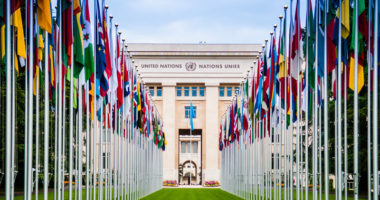The international armed conflict between Russia and Ukraine has revealed a knowledge gap across the global financial sector regarding exposure to armed conflict, reiterating an already pressing need to deepen corporate understanding of international humanitarian law (IHL). Although there is mounting pressure on companies to conduct structured and informed heightened human rights due diligence when investing or doing business in conflict-affected contexts, more must be done to effectively embed IHL and conflict sensitivity into corporate policies and practices. In 2022, Australian Red Cross engaged Deloitte Australia to undertake a review of the extent to which the Australian financial sector incorporates IHL and conflict-related considerations in investment and operational decision-making.
In this post, Australian Red Cross Legal Adviser, Fauve Kurnadi, and Australian lawyer, Adaena Sinclair-Blakemore, discuss some of the findings from this report, including risks and trends in the Australian financial sector and the growing relevance of IHL to financial institutions, as well as what certain actors like the Responsible Investment Association of Australasia are doing to address IHL knowledge and implementation gaps that exist across the sector.
The international armed conflict between Russia and Ukraine is having a devastating humanitarian impact and has prompted an outpouring of support around the world for those affected. The conflict has also had an unexpected impact on the way in which international humanitarian law (IHL) is understood and discussed in the private sector.
Following the escalation of violence in February 2022, multinational corporations across various industries – including financial services, natural resources, manufacturing, professional services, and technology – withdrew from or suspended their operations in Russia. In large part, the exodus from Russia was a response to global pressure to conduct business operations responsibly in the region. However, it also formed part of two broader trends. First, towards improved Environmental, Social, and Governance (ESG) integration in companies’ operations. Secondly, in response to calls for heightened human rights due diligence (hHRDD) in conflict contexts.[1]
Despite these trends and the increased scrutiny of corporate commitments to human rights, the Russia-Ukraine international armed conflict has highlighted a lack of understanding when it comes to armed conflict and IHL. This observation is consistent with findings from a confidential research report commissioned by the Australian Red Cross last year, which found that there is limited conflict awareness and integration of conflict-related issues in policies and reports in the Australian financial sector.
Financial institutions are in a unique position to lead on global best practices. They have the resources and capacity to exert significant influence, and drive behavioural change, through their investment decisions. However, to achieve this, more must be done to overcome the apparent lack of IHL awareness and integration in the financial sector. In May 2023, the Responsible Investment Association Australasia (RIAA) released its Investor Toolkit on Human Rights and Armed Conflict – one of the first guides written by investors for investors on the topic – marking a positive step forward for the development of IHL-specific guidance and conflict-sensitive standards in responsible investment practices.
Is IHL relevant to financial institutions?
All parties to an armed conflict, whether they are government armed forces or non-state armed groups, are bound by IHL. If and how IHL applies to other actors, such as private business enterprises, is not often debated or well understood. Yet, IHL has implications for businesses and individual corporate actors in circumstances where their activities are “closely linked” to an armed conflict.
This concept of “closely linked” in the context of private actors is not clearly defined, but this connection raises a number of legal, financial, operational, and reputational risks. Importantly for financial institutions, “closely linked” activities include not only those which demonstrate a direct link between the business and the armed conflict but also an indirect link. Indeed, it is not necessary that the activity involves active fighting or take place during actual hostilities or on the physical battlefield. For example, if a bank were to facilitate payments by one party to an armed conflict that are used to fund their military operations, this may be considered “closely linked”.
Voluntary human rights frameworks, such as the UN Guiding Principles on Business and Human Rights (UNGPs), offer a standardized way of thinking about social sustainability and responsible business conduct and are widely and globally accepted by private actors. There is also a growing suite of reporting and disclosure requirements compelling financial institutions to be more transparent about how they invest. In many cases, these frameworks and guidelines include explicit references to IHL. For example, the commentary to Principle 12 of the UNGPs states that “in situations of armed conflict enterprises should respect the standards of international humanitarian law”. Yet, in every instance, further commentary and interpretive guidance fail to articulate actual steps towards effective IHL integration. This has left any genuine and formal consideration of IHL and conflict sensitivity in the periphery of the business and human rights dialogue.
A lack of IHL awareness in the financial sector
In 2022, the Australian Red Cross engaged Deloitte Australia to review the extent to which the Australian financial sector incorporates IHL and conflict-related considerations in investment and operational decision-making, and whether these considerations should form part of ESG or responsible investment practices moving forward. Findings from this confidential report revealed that there is limited conflict awareness and engagement with IHL across the sector, and that significant knowledge gaps exist regarding organizational exposure to conflict-affected areas and conflict-related risks.
The report also found that Australian financial institutions demonstrated a risk-averse approach to conflict, resulting in avoiding doing business in certain countries or regions. While these practices are driven largely by reputational and compliance concerns, they also lead to a perception that IHL is not relevant to those institutions’ operations.[2] Similarly, this fails to recognize the importance of a proactive approach that considers and prepares for conflict during peacetime.
However, the research also revealed that there is a growing interest among financial institutions to better understand and implement a conflict-sensitive approach to business and investment.[3] The growing scrutiny of global supply chains and modern slavery has heightened awareness of the need to ensure that investments and operations are not contributing to violations of international law.[4]
In some cases, actors like RIAA, and specifically their Human Rights Working Group, have taken positive steps towards establishing IHL-specific guidance and conflict-sensitive standards for responsible investment practices in armed conflict. In May 2023, RIAA released its Investor Toolkit on Human Rights and Armed Conflict. The guide was designed to assist investors in managing human rights impacts and IHL implications before, during, and after armed conflicts. This toolkit isn’t the first analysis of conflict sensitivity and its relevance to business – the UNDP, for example, released an excellent guide on heightened human rights due diligence in conflict-affected areas in June 2022 – but it is one of the very few resources written by investors for investors that addresses IHL-related risk in addition to human rights risk. The toolkit provides valuable context for investors about what armed conflict is, how to identify actual and potential adverse human rights and conflict-related impacts, and how investors can engage with companies on these issues before, during, and after armed conflict.
Why should the financial sector care about IHL?
There are several reasons why the financial sector should care about integrating a conflict-sensitive approach and respect for IHL into investment practices. First, “there is a growing recognition amongst investors that failure by companies to manage human rights risks poses regulatory, financial, legal and reputational risks … [and] these risks are heightened in conflict-affected contexts.”[5]
Second, IHL integration complements a broader trend towards doing business responsibly and in line with voluntary or mandatory human rights regulations. For example, in accordance with international frameworks and guidelines, like the UNGPs and the Sustainable Development Goals (SDGs), and with mandatory human rights due diligence laws, such as those introduced in France, Germany, and Norway.
Finally, non-compliance with the rules of IHL may lead to significant legal liability for businesses. In respect of civil liability, businesses can be, and in the past have been, sued for wrongdoing in conflict-affected areas by individual victims. Civil claims have been launched in the United States and Europe, including against major Australian companies. Violations of IHL also entail criminal liability. Corporations, and the individuals connected to them, can be charged with war crimes. They can be prosecuted under domestic criminal law – for instance in Australia, under Division 268 of the Criminal Code Act 1995 (Cth) – or under international criminal law.
Towards best, or better, practice
If financial institutions wish to implement responsible business and investment practices genuinely and meaningfully, in line with international frameworks, a conflict-sensitive approach is crucial. There are more than 100 armed conflicts taking place around the world today, and these are increasing in number, scale, and complexity. A misappreciation or misunderstanding of conflict-related risks will not only have a devastating impact on the people impacted by them but will also hinder broader efforts towards responsible business conduct in conflict-affected or conflict-prone regions. For companies and the institutions that invest in them, understanding and upholding conflict-sensitive practices that embed IHL will give them a greater chance of managing investment risks, encouraging best practices, and respecting the lives and dignity of those affected by armed conflict.
Want to know more?
If you’re interested in learning more, Australian Red Cross and RMIT University have developed a suite of materials that highlight the relevance of IHL to the private sector. Visit the Australian Red Cross Business and IHL Hub to learn more, and consider taking our 4-week online course, International Humanitarian Law for Business, open for registration here.
The International Committee of the Red Cross (ICRC), the Geneva Centre for Security Sector Governance (DCAF), and the Geneva Centre for Business and Human Rights (GCBHR) have released an updated version of their Security and Human Rights Toolkit. The Toolkit is designed for any company facing security and human rights challenges in complex environments and can support the work of governments, international organizations, civil society, and investors committed to promoting responsible business conduct. Visit the Security and Human Rights Knowledge Hub for further information.
[1] Deloitte 2022, Responsible business and international humanitarian law in the finance sector, unpublished confidential report.
[2] Ibid
[3] Ibid
[4] Ibid
[5] Responsible Investment Association Australasia 2023, Investor Toolkit on Human Rights and Armed Conflict, <https://responsibleinvestment.org/wp-content/uploads/2023/05/Investor-Toolkit-on-Human-Rights-and-Armed-Conflict.pdf>, p 13.
See also:
- Colin Walch, “Supporting social protection: five considerations for a principled humanitarian approach”, June 8, 2023
- Namita Khatri, “Who gets what: how to get climate finance working for the people who need it most”, November 10, 2022
- Kelisiana Thynne, ‘It was the best of times; it was the worst of times’: a tale of two cities in the aftermath of conflict”, August 18, 2022







Comments